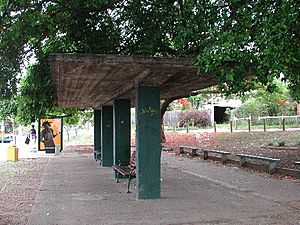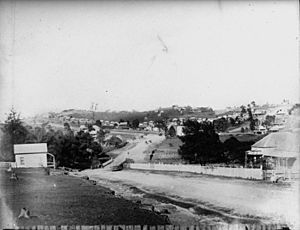Kelvin Grove Fig Trees and Air Raid Shelter facts for kids
Quick facts for kids Kelvin Grove Fig Trees and Air Raid Shelter |
|
|---|---|

Kelvin Grove Air Raid Shelter surrounded by fig trees
|
|
| Location | 176 Kelvin Grove Road, Kelvin Grove, City of Brisbane, Queensland, Australia |
| Design period | 1900 - 1914 (early 20th century) |
| Built | c. 1909 - 1942 |
| Official name: Kelvin Grove Fig Trees and Air Raid Shelter | |
| Type | state heritage (built, landscape) |
| Designated | 31 May 2005 |
| Reference no. | 602196 |
| Significant period | 1942 (fabric) c. 1909-c. 1925, 1942 (historical) |
| Significant components | trees/plantings, air raid shelter |
| Lua error in Module:Location_map at line 420: attempt to index field 'wikibase' (a nil value). | |
The Kelvin Grove Fig Trees and Air Raid Shelter are special heritage-listed trees and an air raid shelter located at 176 Kelvin Grove Road in Kelvin Grove, Brisbane, Queensland, Australia. The trees were planted around 1909, and the shelter was built in 1942 during World War II. Both are important parts of Queensland's history and were added to the Queensland Heritage Register on May 31, 2005.
Contents
The Story of Kelvin Grove's Heritage
This special place tells two different stories from Brisbane's past: one about making the city beautiful with trees, and another about protecting people during wartime.
Why Were the Fig Trees Planted?
The large fig trees you see along Kelvin Grove Road today were planted a long time ago, between the late 1800s and early 1900s. Back then, the area around Kelvin Grove was growing fast. Many small houses were being built, and the natural trees were often cut down.
The local government, called the Ithaca Town Council at the time, wanted to make the area look nicer. They started a big project to improve the town and make it more beautiful. This included planting many street trees.
In 1908, people started talking about planting trees near the sports ground. In 1909, the owner of the Normanby Hotel even offered money to help plant trees at the Normanby Fiveways. It seems the fig trees along Kelvin Grove Road were planted around this time. The Mayor of Ithaca, George Hall, mentioned in 1909 that "Shade trees have been planted at the Normanby, along the Kelvin Grove Road."
The trees in Marshall Park, a narrow strip of parkland, were also planted around this period. By 1922, photos show these trees were already quite tall. The Ithaca Town Council continued planting trees and improving roads for over two decades. They encouraged residents to help make the town greener too.
So, these big, old fig trees are a reminder of how people worked to make Brisbane a more beautiful and green city in the early 1900s.
The Air Raid Shelter: A Wartime Hideaway
The concrete shelter at Kelvin Grove was built in 1942 during World War II. This was a time when Australia faced a real threat of attack from Japan. After the bombing of Pearl Harbor in December 1941, and the fall of Singapore in early 1942, Australians became very worried. Japanese planes even bombed Darwin.
To keep people safe, the Brisbane City Council was ordered to build many public air raid shelters. These shelters were strong concrete buildings designed to protect people from bombs during air raids. They were often built in parks or along streets.
How Many Shelters Were Built?
The Brisbane City Council was told to build 200 public shelters, and later another 75 were ordered. In the end, about 235 air raid shelters were built in Brisbane. Many more were built in other coastal towns in Queensland.
Most of these shelters were simple "pillbox" designs, meaning they were like a solid concrete box. However, the City Architect, Frank Gibson Costello, had a clever idea. He designed some shelters, like the one at Kelvin Grove, to be "reusable."
A Clever Design for the Future
Costello wanted these shelters to have a purpose even after the war ended. He designed them so that their thick outer walls could be removed. This would turn them into useful structures like bus stops or park shelters. This was a smart way to avoid having many useless concrete boxes left around the city after the war.
The Kelvin Grove shelter is an example of Costello's "park" type design. It has four strong concrete pillars supporting a heavy roof. After the war, the blast walls were taken away, and it became a bus shelter, just as planned. You can still see where the walls used to be.
Many wartime structures were removed after World War II, but some of Costello's reusable shelters, including the one at Kelvin Grove, survived because they could be used for something else.
What Do They Look Like Today?
The fig trees and the air raid shelter are still important parts of the Kelvin Grove area.
The Magnificent Fig Trees
The fig trees are spread out over about one kilometre along Kelvin Grove Road. They create a grand entrance to the Brisbane central business district when you drive along this major road.
- Normanby Group: Near the Normanby Fiveways, there are five large Weeping Figs (a type of fig tree called Ficus benjamina). Even with new roads and bypasses, these trees are huge and stand out.
- Marshall Park Group: In Marshall Park, there are seven Hill's Fig Trees (another type, Ficus microcarpa var. hillii). They form a line along the road, providing shade and a green barrier between the busy road and nearby houses. There's also playground equipment under them.
- Prospect Terrace Group: At the corner of Prospect Terrace, there are three more Weeping Figs. This triangular area also has other plants and the air raid shelter.
The Air Raid Shelter Today
The shelter is a rectangular concrete building. It has a strong concrete floor and a flat roof supported by four concrete pillars. A branch from a nearby fig tree has even grown onto the roof! Inside, there are seats, showing its current use as a bus shelter.
Why Are They Heritage Listed?
The Kelvin Grove Fig Trees and Air Raid Shelter were added to the Queensland Heritage Register because they are very important for several reasons:
- Showing History: The fig trees show how the Ithaca Town Council worked hard to make the town beautiful in the early 1900s. The air raid shelter shows how Brisbane prepared to protect its people during World War II.
- Rare Survivors: Many air raid shelters were built during the war, but only a few like this one still exist. It's rare to find structures built by the Brisbane City Council specifically for wartime that are still standing.
- Typical Design: The shelter's strong build and location near people show what a typical public air raid shelter looked like during World War II. It also shows the clever work of City Architect F.G. Costello.
- Beautiful to Look At: The large, mature fig trees are beautiful and create a special feeling as you enter Brisbane's city centre. They provide welcome shade and a tropical feel.
- Clever Design: The shelter is a great example of how wartime buildings could be designed for a second use after the war. It shows smart use of concrete technology.
- Community Value: The trees are important to the local community. People value them so much that they protested when there was a plan to cut down some of them in 1996.



